Home on laptop batteries 🙂 .
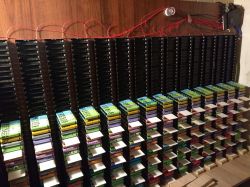
Usability testing of the eperimental-experimental 48V energy storage on 18650 cells completed.
As an answer to the eternal question "what else would you build ?", I built a "Paragon" class energy storage inspired by Leszek Kwitek https://www.youtube.com/watch?v=7a0CGuDVCBo.
After 3 months of testing with half of the capacity filled (estimated actual capacity at the moment around 12kWh, once full it will be over 24kWh), the whole thing works sensationally 🙂 .
All 18650 cells recycled. The storage after charging easily keeps the house for the next 2 cloudy days when the installation does not yield, if there are bright clouds then longer. With heavy use such as cooking dinner (induction cooker), teas, coffees, hoovering, hairdryer, my workshop work etc, the "holding" time is about 36 hours, after which it will switch to grid i.e. grid or sunshine comes out 🙂 .
I make no secret of the fact that this is a job for the patient, the persistent and those with a clue. A time-consuming and labour-intensive challenge is the very process of recovering, selecting and testing 18650 cells, a separate elaboration could be written about this process.
The cells were welded with a DIY welder assembled "on the cheap" from a microwave transformer with a universal controller, the construction of which I have described here https://www.elektroda.pl/rtvforum/topic4053341.html.
The welding and printing hoof I designed can be downloaded here https://www.thingiverse.com/thing:6808297
The storage works with a 5.5kW hybrid inverter and 4.7kW panels mounted vertically (an idea that works brilliantly), for the best yield in the autumn/winter/spring months when energy demand is greatest (including for reheating the house).
In summary, this form of storage is very convenient for utility and service purposes (adding cells online, without shutting down), the temperature culture of operation is excellent, the current carrying capacity is seamless, where per cell the currents are in the order of 250-350mA, which will hopefully ensure a long life.
Technikalia :
- 14S , 48V , 40 strings x 6 cells (target)
- Cell test : tested with LiitoKala Lii-500 chargers, they perform well in this regard
- BMS: JK BMS 20S balancer 1A, very good device, I recommend, 1A can handle balancing without any problem
- string batteries are selected and connected together with regard to capacity and internal resistance
- fuses: 4A but I would now use 5-6A
- operating thresholds of the cells: lower 3.3V , upper 4.13V, so with a margin (the settings take into account the inverter measurement error offset)
- the middle 8 strings at the terminals have 8A fuses (2x4A) and the best cells are there
- cyclic thermal imaging control, any anomalies are seen immediately but nothing happens
- cost-wise: an unbeatable revelation 🙂
- The welding and printing holder I designed is downloadable from thingiverse .
I attach a couple of photos from construction and testing
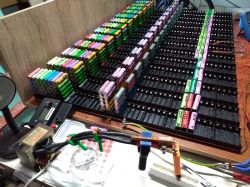

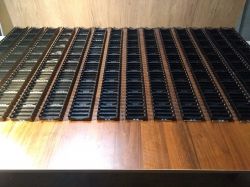 fa7a1293
fa7a1293

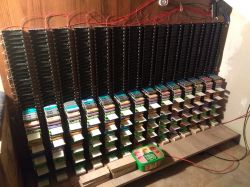 .
.
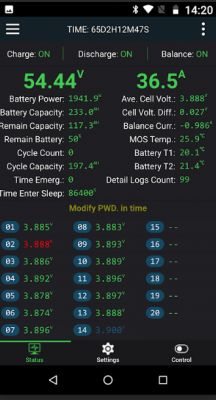

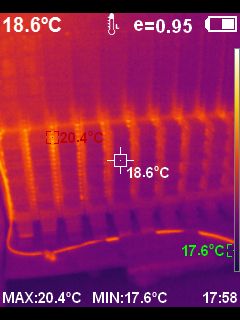
 .
.
EDIT
I'm uploading additional descriptions from the Facebook discussion
Question: Let us know what condition the cells you still need should be in - could they be used but still working, or could they already be old, weak, and you are somehow remanufacturing them?
Answer: Cells should not be badly corroded (there are ways to get slightly corroded cells 🙂 ), besides, their condition before testing is irrelevant, they can be discharged to 0V, the initial condition is completely irrelevant to the quality of the cell and its wear - this will only become apparent after testing. Testing is the whole procedure to check the internal CID fuse, if the cell is completely discharged then "raise" it by 50-100mA to the catalogue threshold and after that charge with temperature control, discharge with temperature control, charge by 700mA with temperature control, measure the internal resistance, let it rest for about a month and measure again to assess possible self-discharge problems. If the cell passes all this procedure, it is suitable for storage 🙂 . If the cell has a damaged insulating sleeve then it is repackaged in new "clothing". And if it has some minor imperfections, then it is suitable for LED torches 🙂 .
Experience shows that laptop cells have a lot of rejects and a large range of parameters (but it is possible to squeeze something out of them), and the best for recovery are damaged packs from e-bikes, scooters, boards, etc.
Question: You have 5 batteries combined into one pack. My question is what happens if one battery out of these 5 makes a short circuit?
Answer: This string with the 5'ohm already has a 6'ste cell added to it just like the rest of the strings, there are 6 everywhere. A short circuit doesn't happen so it doesn't and it's there, but if it does, it's a slow process and the cell will slowly get warmer than the others, which you can see right away on the thermal imaging camera, giving you a ton of time to replace it. But assuming it suddenly short-circuits, it will trip the CID fuse that is in each cell. Assuming the CID doesn't work it will discharge the other cells in the pack and of course my fuse put on the pack will work. Same if corrosion occurs and the electrolyte leaks/leaks. So much.
BTW I've taken apart thousands of cells and unpacked hundreds of packs, and I've seen them in various states, rusted to the core, overflowing, falling apart, with beaten CID fuses (sometimes a whole pack of 50 or so cells had their CIDs beaten and went to waste), discharged to 0V etc. but I've never, I repeat NEVER found a cell that was short-circuited or short-circuited, nor any burnt out. That's basically as much of a quandary as what happens if it gets a short circuit 🙂 basically from a purely practical point of view it's the same dilemma as - what if granny had a moustache would she be a grandpa 🙂 and that's why I consider 18650 cells to be very safe.
Comment from FB:
Comments by "łolabogaspalisiejakkamiennaawPoznan" for 3.... 2... 1...
-
Hehe good , a rash of "trolls" "pyromaniacs" "firefighters" frothing and bludgeoning endlessly, on such a topic is inevitable
, a rash of "trolls" "pyromaniacs" "firefighters" frothing and bludgeoning endlessly, on such a topic is inevitable  .
.
Diagram of the warehouse, connection to the BMS
 .
.
Update 05.2025
For over a month now, the storage has completely paid for itself, so after a full financial 'blip', everything is now going to the upside. Current capacity around 20kWh.
As befits an experimental storage facility - the experiment continues - and continues to run .
.
Next information , sometime in March I noticed that some of the cell sockets from one batch started to crack after a while, so within two weeks (fortunately these were weeks of total sunlessness) the storage was rebuilt to mechanically prevent this kind of fault in the future. The cracked sockets were replaced. The sockets which have the print on them are OK and nothing happens to them, but the ones from the Chinese supplier which do not have such prints and numbers - have started to break, so I LOSE to the quality of some Chinese stuff.
Below are pics of how they break down and how I rebuilt the stock (disassembly/disassembly was one afternoon - I was surprised myself at how quickly something can be taken apart ).
).

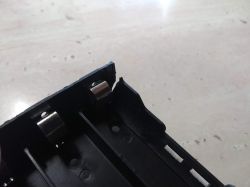 .
.
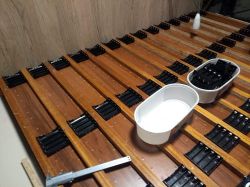
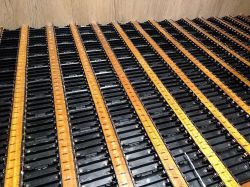 .
.
By the way, I am throwing in an example of a cell caught during a periodic thermal imaging inspection, a point of higher temperature by 3 degrees relative to the background, a cell that got a slight leak (after removing the tee shirt, I found a tiny electrolyte leak, a droplet). There was still a long way to go before such a cell was destroyed, maybe 3-6 months, but the thermal imaging had already caught the "dude" early enough - the cell was of course replaced immediately (without shutting down the storage), service-wise the design works.
Here the thought really comes to mind that if the factory packs were not sealed and people/users were able to check with thermal imaging, the number of different "accidents" could be significantly reduced.



Usability testing of the eperimental-experimental 48V energy storage on 18650 cells completed.
As an answer to the eternal question "what else would you build ?", I built a "Paragon" class energy storage inspired by Leszek Kwitek https://www.youtube.com/watch?v=7a0CGuDVCBo.
After 3 months of testing with half of the capacity filled (estimated actual capacity at the moment around 12kWh, once full it will be over 24kWh), the whole thing works sensationally 🙂 .
All 18650 cells recycled. The storage after charging easily keeps the house for the next 2 cloudy days when the installation does not yield, if there are bright clouds then longer. With heavy use such as cooking dinner (induction cooker), teas, coffees, hoovering, hairdryer, my workshop work etc, the "holding" time is about 36 hours, after which it will switch to grid i.e. grid or sunshine comes out 🙂 .
I make no secret of the fact that this is a job for the patient, the persistent and those with a clue. A time-consuming and labour-intensive challenge is the very process of recovering, selecting and testing 18650 cells, a separate elaboration could be written about this process.
The cells were welded with a DIY welder assembled "on the cheap" from a microwave transformer with a universal controller, the construction of which I have described here https://www.elektroda.pl/rtvforum/topic4053341.html.
The welding and printing hoof I designed can be downloaded here https://www.thingiverse.com/thing:6808297
The storage works with a 5.5kW hybrid inverter and 4.7kW panels mounted vertically (an idea that works brilliantly), for the best yield in the autumn/winter/spring months when energy demand is greatest (including for reheating the house).
In summary, this form of storage is very convenient for utility and service purposes (adding cells online, without shutting down), the temperature culture of operation is excellent, the current carrying capacity is seamless, where per cell the currents are in the order of 250-350mA, which will hopefully ensure a long life.
Technikalia :
- 14S , 48V , 40 strings x 6 cells (target)
- Cell test : tested with LiitoKala Lii-500 chargers, they perform well in this regard
- BMS: JK BMS 20S balancer 1A, very good device, I recommend, 1A can handle balancing without any problem
- string batteries are selected and connected together with regard to capacity and internal resistance
- fuses: 4A but I would now use 5-6A
- operating thresholds of the cells: lower 3.3V , upper 4.13V, so with a margin (the settings take into account the inverter measurement error offset)
- the middle 8 strings at the terminals have 8A fuses (2x4A) and the best cells are there
- cyclic thermal imaging control, any anomalies are seen immediately but nothing happens
- cost-wise: an unbeatable revelation 🙂
- The welding and printing holder I designed is downloadable from thingiverse .
I attach a couple of photos from construction and testing


 fa7a1293
fa7a1293

 .
.



 .
.
EDIT
I'm uploading additional descriptions from the Facebook discussion
Question: Let us know what condition the cells you still need should be in - could they be used but still working, or could they already be old, weak, and you are somehow remanufacturing them?
Answer: Cells should not be badly corroded (there are ways to get slightly corroded cells 🙂 ), besides, their condition before testing is irrelevant, they can be discharged to 0V, the initial condition is completely irrelevant to the quality of the cell and its wear - this will only become apparent after testing. Testing is the whole procedure to check the internal CID fuse, if the cell is completely discharged then "raise" it by 50-100mA to the catalogue threshold and after that charge with temperature control, discharge with temperature control, charge by 700mA with temperature control, measure the internal resistance, let it rest for about a month and measure again to assess possible self-discharge problems. If the cell passes all this procedure, it is suitable for storage 🙂 . If the cell has a damaged insulating sleeve then it is repackaged in new "clothing". And if it has some minor imperfections, then it is suitable for LED torches 🙂 .
Experience shows that laptop cells have a lot of rejects and a large range of parameters (but it is possible to squeeze something out of them), and the best for recovery are damaged packs from e-bikes, scooters, boards, etc.
Question: You have 5 batteries combined into one pack. My question is what happens if one battery out of these 5 makes a short circuit?
Answer: This string with the 5'ohm already has a 6'ste cell added to it just like the rest of the strings, there are 6 everywhere. A short circuit doesn't happen so it doesn't and it's there, but if it does, it's a slow process and the cell will slowly get warmer than the others, which you can see right away on the thermal imaging camera, giving you a ton of time to replace it. But assuming it suddenly short-circuits, it will trip the CID fuse that is in each cell. Assuming the CID doesn't work it will discharge the other cells in the pack and of course my fuse put on the pack will work. Same if corrosion occurs and the electrolyte leaks/leaks. So much.
BTW I've taken apart thousands of cells and unpacked hundreds of packs, and I've seen them in various states, rusted to the core, overflowing, falling apart, with beaten CID fuses (sometimes a whole pack of 50 or so cells had their CIDs beaten and went to waste), discharged to 0V etc. but I've never, I repeat NEVER found a cell that was short-circuited or short-circuited, nor any burnt out. That's basically as much of a quandary as what happens if it gets a short circuit 🙂 basically from a purely practical point of view it's the same dilemma as - what if granny had a moustache would she be a grandpa 🙂 and that's why I consider 18650 cells to be very safe.
Comment from FB:
Comments by "łolabogaspalisiejakkamiennaawPoznan" for 3.... 2... 1...
-
Hehe good
Diagram of the warehouse, connection to the BMS
 .
.
Update 05.2025
For over a month now, the storage has completely paid for itself, so after a full financial 'blip', everything is now going to the upside. Current capacity around 20kWh.
As befits an experimental storage facility - the experiment continues - and continues to run
Next information , sometime in March I noticed that some of the cell sockets from one batch started to crack after a while, so within two weeks (fortunately these were weeks of total sunlessness) the storage was rebuilt to mechanically prevent this kind of fault in the future. The cracked sockets were replaced. The sockets which have the print on them are OK and nothing happens to them, but the ones from the Chinese supplier which do not have such prints and numbers - have started to break, so I LOSE to the quality of some Chinese stuff.
Below are pics of how they break down and how I rebuilt the stock (disassembly/disassembly was one afternoon - I was surprised myself at how quickly something can be taken apart

 .
.

 .
.
By the way, I am throwing in an example of a cell caught during a periodic thermal imaging inspection, a point of higher temperature by 3 degrees relative to the background, a cell that got a slight leak (after removing the tee shirt, I found a tiny electrolyte leak, a droplet). There was still a long way to go before such a cell was destroyed, maybe 3-6 months, but the thermal imaging had already caught the "dude" early enough - the cell was of course replaced immediately (without shutting down the storage), service-wise the design works.
Here the thought really comes to mind that if the factory packs were not sealed and people/users were able to check with thermal imaging, the number of different "accidents" could be significantly reduced.


Cool? Ranking DIY




